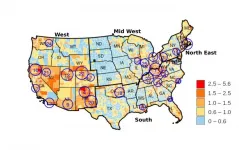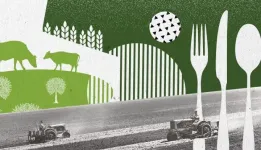(Press-News.org) Continuous skin-to-skin contact starting immediately after delivery even before the baby has been stabilised can reduce mortality by 25 per cent in infants with a very low birth weight. This according to a study in low- and middle-income countries coordinated by the WHO on the initiative of researchers at Karolinska Institutet published in The New England Journal of Medicine.
Continuous skin-to-skin contact between infant and mother, or "Kangaroo Mother Care" (KMC), is one of the most effective ways to prevent infant mortality globally. The current recommendation from the World Health Organization (WHO) is that skin-to-skin contact should commence as soon as a low weight baby is sufficiently stable, which for those weighing under 2 kg at birth normally takes several days.
"The idea of giving skin-to-skin contact immediately after delivery to very small, unstable babies has encountered quite strong resistance, but about 75 per cent of deaths occur before the infant has been judged sufficiently stable," says Nils Bergman, doctor and researcher at the Department of Women's and Children's Health, Karolinska Institutet, Sweden, and one of the initiators of the study.
The new study, financed by the Bill & Melinda Gates Foundation and led by WHO, has examined whether immediate Kangaroo Mother Care, iKMC, after delivery leads to even better survival rates for infants with a birth weight of 1 to 1.8 kg in low- and middle-income countries. The study was conducted at five university hospitals in Ghana, India, Malawi, Nigeria and Tanzania, where mortality for these babies, prior to the study, varied between 20 and 30 per cent.
To improve and align the care to the greatest possible extent between study hospitals before the start of the study, training was provided in basic neonatal care and basic equipment was procured for measuring the babies' oxygen levels and to provide assisted ventilation. The participating hospitals were also trained in safe skin-to-skin contact for unstable infants. The KI researchers, supported by a colleague from the University of Stavanger, Norway, were responsible for the training and, by frequent visits to the study sites, the assurance of quality of the basic care in both groups and iKMC technique in the intervention group.
In the study, 3,211 infants were randomly assigned to two groups, one that received iKMC and continued skin-to-skin contact at the neonatal unit, where the mothers also received their medical care, and a control group that received standard care, whereby mothers and babies are cared for in separate units and are only reunited during infant feeding. As soon as the babies had stabilised sufficiently, mothers and babies from both groups were transferred to the regular KMC unit. During the first 72 hours, the infants in the iKMC group received approximately 17 hours of skin-to-skin contact per day, compared with 1.5 hours in the control group.
Mortality during the first 28 days was 12 per cent in the iKMC group compared to 15.7 per cent in the control group, which corresponds to a reduction of 25 per cent. There were also significantly fewer babies in the iKMC group with a low body temperature or bacterial blood poisoning.
"The main message is that low weight newborns should receive skin-to-skin contact immediately after birth and subsequently at a mother-infant couplet care unit, where mothers and babies are looked after together without having to be separated," says Björn Westrup, consultant and researcher at the Department of Women's and Children's Health, Karolinska Institutet and co-initiator of the study with Nils Bergman. "Our results suggest that this care model, which in itself isn't resource-demanding, could have significant health effects."
The researchers estimate that iKMC has the potential to save the lives of an additional 150,000 small newborns each year.
"Keeping the mother and baby together right from birth, with zero separation, will revolutionise the way neonatal intensive care is practiced for babies born early or small," says Dr Rajiv Bahl, Head of Maternal and Newborn Health Research and Development at WHO and the coordinator of the study. "This study illustrates that kangaroo mother care has the potential to save many more lives if it is started immediately after birth, a finding with relevance for countries of all income levels."
WHO is in the process of reviewing its current recommendations on kangaroo mother care, published in 2015, in light of new evidence. WHO recommends KMC for all babies, but the new study gives important evidence on the lifesaving role of immediate KMC for unstable small babies.
INFORMATION:
No potential conflict of interest relevant to this article was reported.
Publication: "Immediate Kangaroo Mother Care and Survival of Low Birth Weight Infants". Sugandha Arya, Helga Naburi, Kondwani Kawaza, Sam Newton, Chineme Henry Anyabolu, Nils Bergman, Suman P.N. Rao, Pratima Mittal, Evelyne Assenga, Luis Gadama, Roderick Larsen-Reindorf, Oluwafemi Kuti, Agnes Linnér, Sachiyo Yoshida, Nidhi Chopra, Matilda Ngarina, Ausbert Thoko Msusa, Adwoa Boakye-Yiadom, Bankole Peter Kuti, Barak Morgan, Nicole Minckas, Jyotsna Suri, Robert Moshiro, Vincent Samuel, Naana Wireko-Brobby, Siren Rettedal, Harsh Vardhan Jaiswal, M. Jeeva Sankar, Isaac Nyanor, Hiresh Tiwary, Pratima Anand, Alexander Ansah Manu, Kashika Nagpal, Daniel Ansong, Isha Saini, Kailash C. Aggarwal, Nitya Wadhwa, Rajiv Bahl, Björn Westrup, Ebunoluwa Aderonke Adejuyigbe, Gyikua Plange-Rhule, Queen Dube, Harish Chellani, Augustine Massawe. The New England Journal of Medicine, online 26 May 2021, doi: 10.1056/NEJMoa2026486.
https://doi.org/10.1056/NEJMoa2026486
Sister study in high-income countries:
Wibke Jonas at Karolinska Institutet is leading a parallel study - the Immediate Parent Infant Skin-To-Skin Study (IPISTOSS) - with the same intervention but under well-resourced conditions at Karolinska University Hospital and Stavanger University Hospital. Here, underlying mechanisms, mother-baby interaction and the possible part played by iKMC in the infant maturing process and long-term development are studied. The primary financiers are the Laerdal Foundation, Baby Björn, the Swedish Research Council, the Kempe Carlgrenska Foundation, Region Stockholm, Lilla Barnets Fond, and Karolinska Institutet.
ITHACA, N.Y. - Soil carbon storage, carbon capture and storage, biochar - mention these terms to most people, and a blank stare might be the response.
But frame these climate change mitigation strategies as being clean and green approaches to reversing the dangerous warming of our planet, and people might be more inclined to at least listen - and even to back these efforts.
A cross-disciplinary collaboration led by Jonathon Schuldt, associate professor of communication at Cornell University, found that a majority of the U.S. public is supportive of soil carbon storage as a climate change mitigation strategy, particularly when that and similar approaches are seen as "natural" strategies.
"To me, that psychology part - that's really interesting," Schuldt ...
With brilliant colors and picturesque shapes, many crystals are wonders of nature. Some crystals are also wonders of science, with transformative applications in electronics and optics. Understanding how best to grow such crystals is key to further advances.
Scientists from the U.S. Department of Energy's (DOE) Argonne National Laboratory, along with three universities, have revealed new insights into the mechanism behind how gallium nitride crystals grow at the atomic scale.
Gallium nitride crystals are already in wide use in light-emitting diodes, better known as LEDs. They might also be applied to form transistors for high-power switching electronics to make electric grids more energy efficient and smarter. The use of such "smart grids," which ...
The opioid epidemic is taking a deadly toll on people in disproportionate clusters from Cape Cod to San Diego, according to a new study by the University of Cincinnati.
Fatal opiate overdoses are most prevalent among six states: Ohio, Pennsylvania, Kentucky, West Virginia, Indiana and Tennessee. But researchers identified 25 hot spots of fatal opioid overdoses nationwide using data from the Centers for Disease Control and Prevention.
The study demonstrates how both widespread and localized the problem of substance use disorders can be, UC assistant professor and co-author Diego Cuadros ...
What is happening deep beneath the surface of ice planets? Is there liquid water, and if so, how does it interact with the planetary rocky "seafloor"? New experiments show that on water-ice planets between the size of our Earth and up to six times this size, water selectively leaches magnesium from typical rock minerals. The conditions with pressures of hundred thousand atmospheres and temperatures above one thousand degrees Celsius were recreated in a lab and mimicked planets similar, but smaller than Neptune and Uranus.
The mechanisms of water-rock interaction at the Earth's surface are well known, and the picture of ...
Modern-day agriculture faces two major dilemmas: how to produce enough food to feed the growing human population and how to minimize environmental damage associated with intensive agriculture. Keeping more nitrogen in soil as ammonium may be one key way to address both challenges, according to a new paper in the Proceedings of the National Academy of Sciences (PNAS).
Today's use of nitrogen fertilizers contributes heavily to greenhouse gas emissions, air pollution, and water pollution, but they are also essential for growing crops. Reducing this pollution is critical, but nitrogen use is likely to grow with increased food production. At ...
UNIVERSITY PARK, Pa. -- One of the most important and widespread reef-building corals, known as cauliflower coral, exhibits strong partnerships with certain species of symbiotic algae, and these relationships have persisted through periods of intense climate fluctuations over the last 1.5 million years, according to a new study led by researchers at Penn State. The findings suggest that these corals and their symbiotic algae may have the capacity to adjust to modern-day increases in ocean warming, at least over the coming decades.
Cauliflower corals -- which are in the genus Pocillopora -- are branching corals that provide critical habitat for one-quarter of the world's fish and many kinds of invertebrates, such as lobsters, sea urchins and giant clams. ...
To help patients manage their mental wellness between appointments, researchers at Texas A&M University have developed a smart device-based electronic platform that can continuously monitor the state of hyperarousal, one of the signs of psychiatric distress. They said this advanced technology could read facial cues, analyze voice patterns and integrate readings from built-in vital signs sensors on smartwatches to determine if a patient is under stress.
Furthermore, the researchers noted that the technology could provide feedback and alert care teams if there is an abrupt deterioration in the patient's mental health.
"Mental health can change very rapidly, and a lot of these changes remain hidden from providers or counselors," said Dr. Farzan Sasangohar, assistant ...
Like a good story, feeding has a beginning, a middle and an end. It begins with appetite prompting the search for food, continues with eating the food and it ends when satiation hits and the consumption of food is stopped.
At Baylor College of Medicine, Dr. Qi Wu, Dr. Yong Han and their colleagues have uncovered new aspects of the last part of this story that relate to the little-known neural circuits and neurotransmitters involved in ending food consumption.
The team discovered a novel circuit that connects a unique subset of dopamine-producing neurons with downstream neurons in the hindbrain (lower brainstem) ...
The province of Quebec is one of only a few jurisdictions to enshrine sustainable development into law. In 2006 the then-Liberal government of Jean Charest adopted the END ...
Up to half of patients with head and neck squamous cell carcinoma will experience tumor recurrence or new tumors--tumors that often spread and are difficult to treat.
A team of scientists led by the University of Michigan School of Dentistry identified a mechanism by which head and neck cancer cells subvert adjacent normal tissue, allowing small clusters of cancer cells to burrow beneath the healthy tissue.
The team decided to look at this particular mechanism in head and neck cancer because a specific gene, DMBT1, appeared on a screen of genes that are silenced during oral cancer, said principal investigator Nisha D'Silva, the Donald A. Kerr Endowed ...




